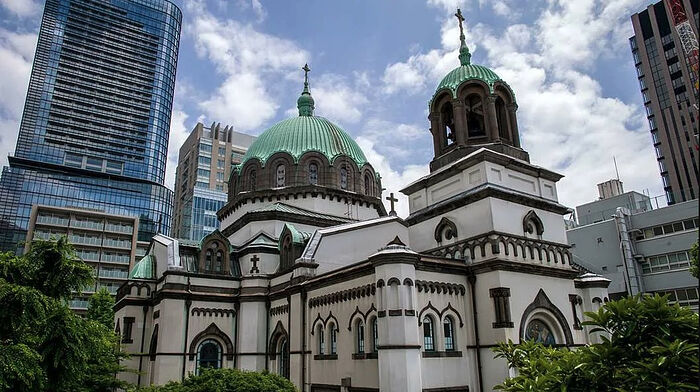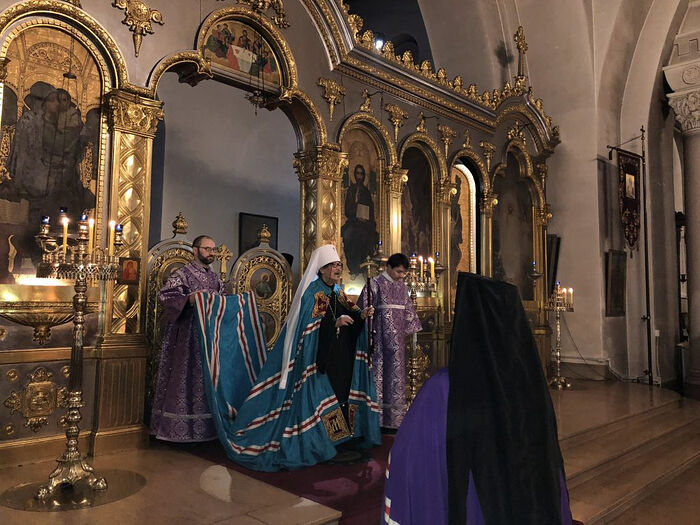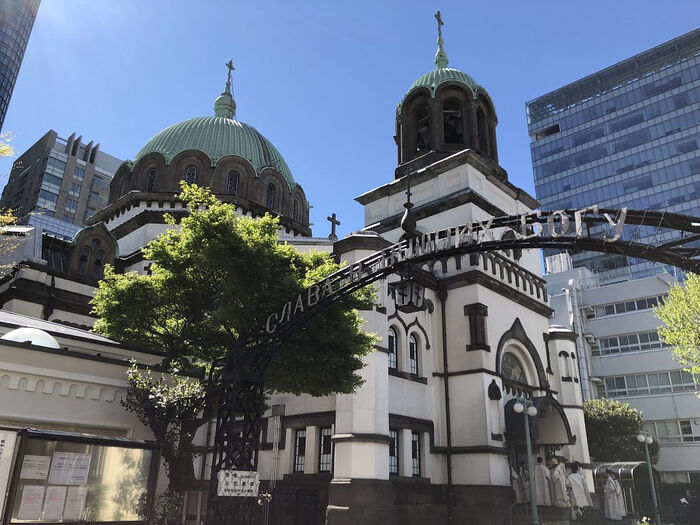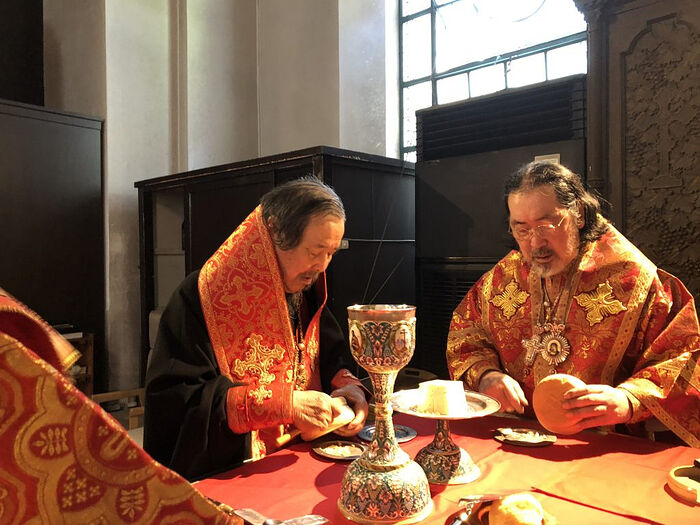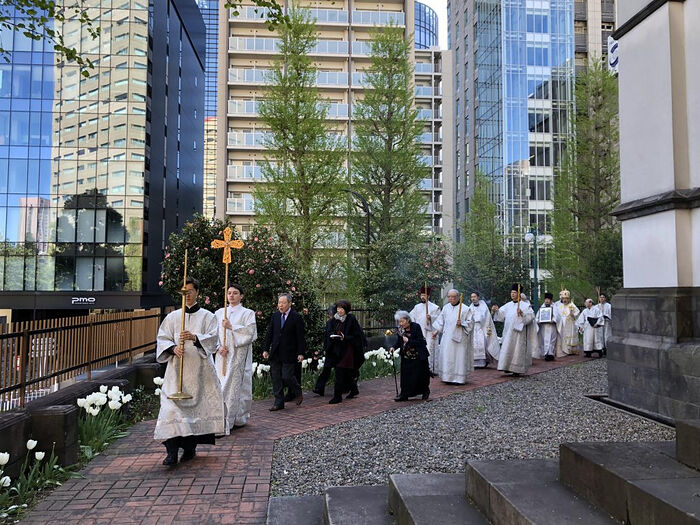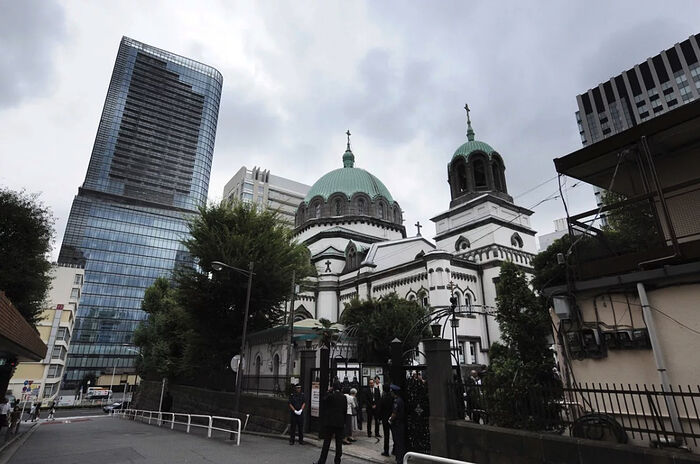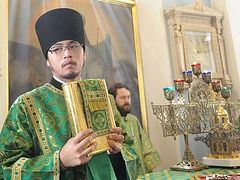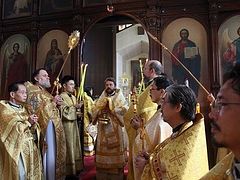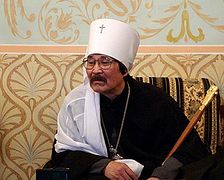It’s about 5,000 miles and nine hours on a plane from Moscow to Tokyo. To fly so far and not visit the main Orthodox church in Japan would be unthinkable, even if you’re going to such a faraway land on a business trip.
What do we know about Japan, about the religion that the locals profess? The majority of them are syncretistic in their faith, simultaneously following the two main religions of Japan—Buddhism and Shintoism. But in this relatively small country there are more than forty active Orthodox churches, and their parishioners aren’t simply Slavs who have moved to Japan, as you might first think. The parishioners of the country’s main Orthodox church—the Cathedral of the Resurrection of Christ in Tokyo—are mainly Japanese. St. Nicholas of Japan was the first to bring Orthodoxy to the Japanese land.
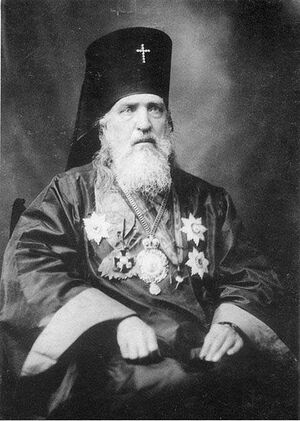 St. Nicholas of Japan, c. 1912 Among the capital city’s skyscrapers, the bright neon signs, and the screaming advertisements, the eye searches for the domes of an Orthodox church. Built on top of Suruga-dai Hill in the Kanda District, the cathedral, which the Japanese call Nikolai-Do (Nicholas Church), blends in quite organically with the urban landscape. The Equal-to-the-Apostles St. Nicholas (in the world Ivan Dmitrievich Kasatkin), who was born in 1836 in the Smolensk Governorate, founded the Orthodox mission in Japan. By his labors and prayers, the inhabitants of the Land of the Rising Sun learned about Christ and heard the evangelical word. In order to preach in the native language of the local people, St. Nicholas learned Japanese. He also looked after a plot of land on which he decided to build an Orthodox church. This was in the late nineteenth century. The design for the church was conceived by architect Mikhail Arephievich Schurupov, and the work on the site was supervised by Nagasato Taisuke.
St. Nicholas of Japan, c. 1912 Among the capital city’s skyscrapers, the bright neon signs, and the screaming advertisements, the eye searches for the domes of an Orthodox church. Built on top of Suruga-dai Hill in the Kanda District, the cathedral, which the Japanese call Nikolai-Do (Nicholas Church), blends in quite organically with the urban landscape. The Equal-to-the-Apostles St. Nicholas (in the world Ivan Dmitrievich Kasatkin), who was born in 1836 in the Smolensk Governorate, founded the Orthodox mission in Japan. By his labors and prayers, the inhabitants of the Land of the Rising Sun learned about Christ and heard the evangelical word. In order to preach in the native language of the local people, St. Nicholas learned Japanese. He also looked after a plot of land on which he decided to build an Orthodox church. This was in the late nineteenth century. The design for the church was conceived by architect Mikhail Arephievich Schurupov, and the work on the site was supervised by Nagasato Taisuke.
Built in the Russian-Byzantine style, the Cathedral of the Resurrection of Christ is a regularly-shaped cross with narrow wings. It’s designed for 2,000 people. Some of the cathedral icons are copies of the works of Viktor Vasnetsov and Mikhail Nesterov. Among the especially venerated icons is the Znamenny Icon of the Mother of God—the main icon of the Russian Orthodox Church Abroad.[1]
And so, for already a century and a half now, the Word of God, the news of the Savior come into the world, has been sounding forth under the arches of the church. Probably the first thing that distinguishes the cathedral from the Orthodox churches erected in Russia is the chairs you can sit on during the Divine services. But I should say that people rarely take advantage of this possibility.
The overwhelming majority of the parishioners are Japanese who have come to believe in Christ and have received Holy Baptism. There’s a large group of parishioners of mixed families, where the wife is Russian or Ukrainian and the husband Japanese. Foreigners also come in, but they speak Japanese, because the services are in Japanese. Only a few litanies are read in English or Church Slavonic.
Usually, tourists or pilgrims from Russia or other countries of the former Soviet Union who want to hear the Church Slavonic language more familiar to them go to Liturgy at St. Alexander Nevsky Church, the representation of the Russian Orthodox Church, or they go to the Romanian representation church.
The primate of the autonomous Japanese Orthodox Church, Metropolitan Daniel of Tokyo and All Japan (Nusiro Ikuo) serves in the cathedral, with four priests helping him. They’re all Japanese and all graduates of the seminary that was opened by the efforts of St. Nicholas and which has never closed.
Metropolitan Daniel, by the way, also graduated from this seminary, and then went to New York, to St. Vladimir’s Seminary, where he received a Master’s degree in theology.
“Enrollment in the seminary changes every year. Sometimes several dozens of future priests are studying, and sometimes just a few people. And sometimes there are none,” says George Troitsky, a subdeacon at the Cathedral of the Resurrection of Christ.
He came to Japan more than a quarter of a century ago, having gotten a degree at the Institute of Asian and African Studies at Moscow State University. Then he studied in a Japanese university—he was in the country for an internship—and now Japan is his second home. During the day he has his main job, and in the evening and on weekends he helps in the cathedral. He’s the only cleric who knows Russian. Among the deacons there are Greeks and Romanians who understand much, but they speak either their native language or Japanese. By the way, many of the priests are fluent in and serve the Liturgy in English, having studied at the seminary in New York where Metropolitan Daniel studied.
In the practice of some foreign Churches, a priest often has to earn a living, mastering some kind of secular profession. That is, he serves on weekends and feasts, but on weekdays he works, for example, as a mailman or a chef. The Orthodox Church of Japan has no such practice. Priests are supported by their parishes.
As a parishioner of a particular church, a person pays regular dues. They can be quite small, but the church lives at the expense of these donations, and not so much at the expense of special services and the sale of candles and other things, as in Russia. When someone is put on the books at a particular parish, he necessarily participates in its life. He’s invited to parish meetings. He becomes a member of a family. The journals of St. Nicholas of Japan describe such parishioner committees, elders with great experience, who help priests in some organizational matters.
This practice also existed in the Russian Orthodox Church before the revolution, but it hasn’t been preserved nearly anywhere in its pure form.
But in general, the life of a parish is very similar to that of a church in, for example, Vladimir or Murmansk. There’s a Sunday School for children, run by the parishioners themselves. After the Sunday Liturgy, there’s always a common meal with a discussion about parish plans, a review of events they held, and congratulations to those celebrating birthdays or name’s days. For those who are planning to be baptized, the priests hold catechetical talks.
And, by the way, they run into one national peculiarity.
“The Japanese have a very different idea of faith, of religion,” says Subdeacon George Troitsky. “Traditionally, they profess Shintoism, Buddhism. These are ritualistic religions. St. Nicholas wrote much about it in his journals. The very concept of the Orthodox faith with prayer, with communion with God is unusual and incomprehensible for them. It’s hard for them to accept that faith is not traditions, not rituals… And the second point: The Japanese are characterized by syncretism in matters of religion. They have no problem with combining different religions. A family could have funerals according to a Buddhist rite, when a child is born it’s dedicated to the gods in a temple (they have a ritual for this) according to a Shinto rite, and marriages could be held according to some other religion’s rites. It often happens that after getting acquainted with Christianity, a Japanese person comes to believe in Christ as the Savior. At the same time, at home, His holy image could wind up next to a statue of Buddha. Yes, they came to believe, but it became one more religion they respect. Such integration of Christianity with paganism is unacceptable. But this is more typical of Asian countries than in others.
Of course, this doesn’t apply to modern Orthodox Japanese. They very carefully preserve the faith; but for traditionally raised Japanese, it’s typical, standard to respect any religion, any gods.
I have to say that respect is synonymous with Japan. If you go there, get ready to say “hello” and “thank you” hundreds of times, and be sure to bow each time. It’s customary. Even a newscaster always makes a small bow after saying goodbye. As my American colleague, with whom I worked together at the Olympics, subtly noted, the Japanese are extremely friendly and polite.
Alas, the youth are not very drawn to faith, although we have to admit that such a situation is developing not only in Japan, but all over the world, perhaps.
Young Japanese people, especially girls, have different priorities, different values. We went to a supermarket in central Tokyo and saw a row of young girls who were patiently waiting their turn to get their picture taken with cardboard cutouts of the members of some popular boy band—not with the actual artists, but with their cutouts. They waited a long time and then took hundreds of photos, now kissing, now hugging, now kneeling (!) in front of these cardboard figures.
Orthodox communities hold educational activities; they invite people to talks, but there are many various strange cults and terrible new religions in Japan, and, alas, they manage to attract many people.
The Cathedral of the Resurrection of Christ in Tokyo has been closed to parishioners for a month now. An emergency regime has been introduced for the duration of the Olympics and Paralympics, and all public institutions have temporarily shut down. The Liturgy is celebrated, but without parishioners.
The Japanese are very law-abiding and observant. If they’re told to wear masks, they’ll wear them outside when it hits 95 to 100°F during the day. And if they’re told the churches are closed, it means no one will go. Alas, there are no TV broadcasts, but church websites have instructions for praying at home.
Alas, I didn’t get to go to Liturgy in the cathedral and hear the Gospel in Japanese. But I hope in God’s help to find myself on the other side of the world again and understand that His power and strength, His love is always with us, wherever we live, in whatever language we praise the Lord.
[1] The Church Abroad’s most revered icon is the wonderworking Kursk Root Icon of the Mother of God, which is of the Znamenny type of icons of the Mother of God.—Trans.

